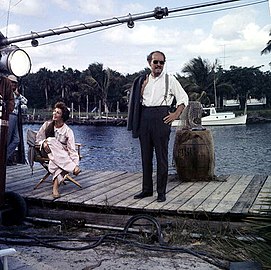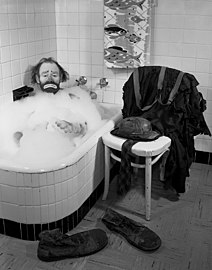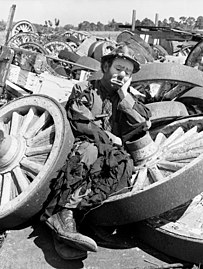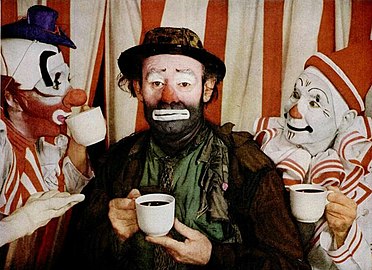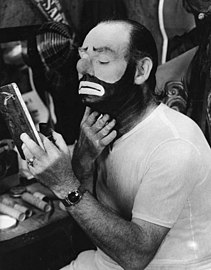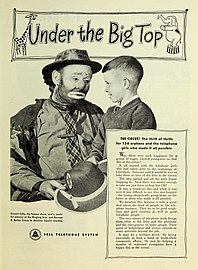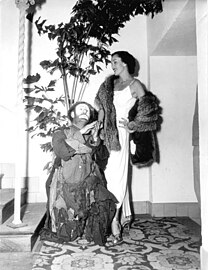Emmett Kelly
Emmett Kelly | |
|---|---|
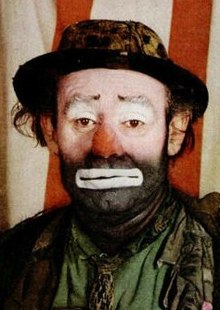 Kelly ca. 1953 | |
| Born | Emmett Leo Kelly December 9, 1898 |
| Died | March 28, 1979 (aged 80) |
| Resting place | Rest Haven Memorial Park, Lafayette, Indiana |
| Other names | Weary Willie |
| Occupation | Circus clown |
| Spouse(s) |
Eva Mae Moore
(m. 1923)Elvira Gebhardt
(m. 1955; "his death" is deprecated; use "died" instead. 1979) |
| Children | 4, including Emmett Leo Kelly Jr., Patrick, Stasia & Monika |
| Signature | |
 | |
Emmett Leo Kelly (December 9, 1898 – March 28, 1979) was an American circus performer, who created the clown figure "Weary Willie," based on the hobos of the Great Depression in the 1930s. According to Charles W. Carey, Jr.:
- Kelly’s creation of Weary Willie revolutionized professional clowning and made him the country’s most familiar clown. The sad-sack, shuffling antics of his unkempt, downtrodden hobo offered a complete contrast to the madcap cavorting of brightly colored, white-faced conventional clowns and has served as an alternate model for professional clowns ever since.[1]
Early life
His father was a railroad worker. He was put in a correspondence school for cartooning by his mother. Subsequently he began entertaining and giving "chalk talks" at local schools.[2]
He moved to Kansas City in 1917, hoping to get a job as a newspaper cartoonist. Unable to be a cartoonist he worked other jobs to support himself. He began working for carnivals and circuses as a laborer, and then eventually trained as a trapeze artist.[3]
Career
He met his first wife, Eva, when working at the John Robinson Circus.[4] They married in 1923.[5] They had a trapeze act together.[6]
During these years he was also working on the Willie character. He had first created Willie as a cartoon character.[7] In the 1920s he began performing as the clown character.[8]
The character caught on with audiences during the Great Depression in the United States. They could identify with a character who wasn't too successful and was sad about his various (comic) failures.[9]
Additionally, Kelly and Eva divorced, and he worked his sadness over the divorce into his clown act.[10]
Kelly appeared with a number of circuses, most prominently that of Ringling Bros. and Barnum & Bailey, which he joined in 1942 and remained with until 1956.[11][12]
Kelly appeared in the 1952 Oscar winner for Best Picture The Greatest Show on Earth. In 1956, he starred in a dramatic role, a TV adaptation of the story of Wilhelm Voigt, the "Captain From Kopenick," who masqueraded as a Prussian officer in 1906. It was broadcast as part of the Telephone Time anthology series.[13]
Kelly was a Mystery Guest on the March 11, 1956, broadcast of What's My Line? and answered the panelists' questions with grunts rather than speaking yes or no. When the round was over, panelist Arlene Francis mentioned that Kelly was not allowed to speak while in makeup.[14]
In 1967, he starred in the musical The Clown and the Kids, which was shot and produced in Bulgaria.[15]
By the time of his death, Kelly had become the most famous clown in the world.[16]
Hartford circus fire
On July 6, 1944, Kelly was preparing to perform in a matinee show of the Ringling Brothers Circus for an audience of 6,000 in Hartford, Connecticut.[17] Twenty minutes into the show, the circus tent, which had been waterproofed with paraffin wax and gasoline, caught fire.[18] Kelly was among those who acted quickly to help extinguish the fire, and then he helped panicked audience members—mostly women and children, due to World War II—to swiftly exit the tent.[19] Officially, 168 people died in the fire, and 682 people were injured.[17] The cause of the fire was never determined.[17]
Kelly's actions that day were immortalized by audience member Ralph Emerson, who took a photograph of Kelly rushing toward the burning tent in his full clown make-up and costume, carrying a single bucket of water.[19] The photograph was published in Life on July 17, 1944.[20] According to eyewitnesses, Kelly was seen to be crying.[21]
The fire affected Kelly deeply and for the remainder of his life; according to his grandson, Joey Kelly, he "rarely spoke of the fire to anyone other than family."[19]
Death
Emmett Kelly died of a heart attack on March 28, 1979, at his home in Sarasota, Florida. He is buried in the Rest Haven Memorial Park, in Lafayette, Indiana.[22]
Legacy
This section needs additional citations for verification. (April 2020) |
Kelly's son, Emmett Kelly Jr., did a similar "Weary Willie" character; the two were estranged for many years as a result.[23] Kelly Jr. died in 2006.[24]
Kelly's boyhood town of Houston, Missouri, named Emmett Kelly Park in his honor and hosted an annual Emmett Kelly Clown Festival, which attracted clowns from across the region, including Kelly's grandson, Joey Kelly, who returned every year to perform as a special guest. According to Joey Kelly's website, the festival ended its 21-year run in May 2008.[25][26]
According to the documentary Halloween Unmasked, the choice for the mask of the film's fictional serial killer Michael Myers was down to two: a modified Captain Kirk mask and an Emmett Kelly mask. While the Emmett Kelly mask was unsettling and eerie, it did not quite evoke the creepy feeling they were seeking. The Kirk mask did, resulting in the crew selecting it for the film.[27]
Gallery
-
Kelly and Chana Eden in 1958 on set of Wind Across the Everglades
-
Kelly in a bubble bath (photo by Joseph Janney Steinmetz)
-
Emmett Kelly as Weary Willie
-
Emmett Kelly in his Weary Willie persona (center) with two Ringling Bros. whiteface clowns in a 1953 advertisement for the Pan-American Coffee Bureau
-
Emmett Kelly getting ready for the show- Sarasota, Florida
-
Emmett Kelly, Bell Telephone System advertisement 1949
-
Kay Hernan and Emmett Kelly in Florida 1948
References
- ^ Carey, 1999.
- ^ "Emmett Kelly - Kansapedia - Kansas Historical Society". www.kshs.org. Retrieved 2021-09-10.
- ^ "Emmett Kelly - Kansapedia - Kansas Historical Society". www.kshs.org. Retrieved 2021-09-10.
- ^ "Emmett Kelly Famous Circus Clown". Circuses and Sideshows.com. Retrieved 2020-01-14.
- ^ "Emmett Kelly". SHSMO Historic Missourians. Retrieved 2021-09-10.
- ^ "Emmett Kelly". SHSMO Historic Missourians. Retrieved 2021-09-10.
- ^ "Emmett Kelly | Biography & Facts". Encyclopedia Britannica. Retrieved 2021-09-10.
- ^ "Emmett Kelly". SHSMO Historic Missourians. Retrieved 2021-09-10.
- ^ "Emmett Kelly". SHSMO Historic Missourians. Retrieved 2021-09-10.
- ^ "Emmett Kelly". SHSMO Historic Missourians. Retrieved 2021-09-10.
- ^ "Emmett Kelly | Biography & Facts". Encyclopedia Britannica. Retrieved 2021-09-10.
- ^ "Emmett Kelly - Kansapedia - Kansas Historical Society". www.kshs.org. Retrieved 2021-09-10.
- ^ Tops, T.V. (22 April 1956). "Famous Clown Takes a Straight Dramatic Role". San Bernardino Sun-Telegram. p. 22. Retrieved 13 May 2018 – via Newspapers.com.
- ^ Host: John Charles Daly (March 11, 1956). "Emmett Kelly". What's My Line. 4:49 minutes in.
- ^ Zipes, Jack (2011-01-27). The Enchanted Screen: The Unknown History of Fairy-Tale Films. Routledge. ISBN 978-1135853952.
- ^ "Emmett Kelly - Kansapedia - Kansas Historical Society". www.kshs.org. Retrieved 2021-09-10.
- ^ a b c Tuohy, Lynne (July 3, 1994). "A Tragedy's Long Shadow". Hartford Courant. Archived from the original on 2019-01-19. Retrieved 2019-01-19.
- ^ Condon, Tom (July 2, 2014). "Hartford Circus Fire, Day of panic, Heroes". Hartford Courant. Archived from the original on 2018-08-11. Retrieved 2019-01-19.
- ^ a b c Browning, William (July 6, 2016). "Tears of a Clown". The Paris Review. Archived from the original on 2017-04-16. Retrieved 2020-02-09.
- ^ "The Hartford Circus Fire ~ July 6, 1944". Life. July 17, 1944. Archived from the original on 2017-09-22. Retrieved 2020-02-09.
- ^ Massey, Don; Davey, Rick. The Hartford Circus Fire—A Matter of Degree. Willow Brook Press. Archived from the original on 2006-12-16. Retrieved 2007-05-16.
- ^ "After lifetime of laughter, clown Kelly buried in Lafayette". Journal & Courier. Lafayette, Indiana. Retrieved 2019-01-19.
- ^ Leahigh, John (February 13, 1983). "A third Emmett Kelly takes up clowning". UPI. Retrieved 2020-02-09.
- ^ "Emmett Kelly Jr., Clown, Dies at 83". The New York Times. Associated Press. 2006-12-04. ISSN 0362-4331. Retrieved 2019-01-19.
- ^ "Emmett Kelly Festival". Joey Kelly Circus. Archived from the original on 2009-12-17. Retrieved 2019-01-19.
- ^ "Annual Emmett Kelly Clown Festival cancelled". Houston Herald. March 16, 2009. Retrieved 2020-02-09.
- ^ "Halloween Unmasked: The Definitive Story of Horror's Most Iconic Movie Franchise". The Ringer.
Further reading
- Carey, Jr. Charles W. "Kelly, Emmett" American National Biography (1999) https://doi.org/10.1093/anb/9780198606697.article.1801797
- Kelly, Emmett, with F. Beverly Kelley. Clown: My Life in Tatters and Smiles (1954), autobiography.
- McManus, Donald. Emmett Kelly: The Greatest Clown on Earth (Truman State University Press, 2014).
- Quackenbush, Robert. The Man on the Flying Trapeze: The Circus Life of Emmett Kelly, Sr. Told with Pictures & Song! (Lippincott, 1975).
- Seelye, John D. "The American tramp: A version of the picaresque." American Quarterly 15.4 (1963): 535-553. online

